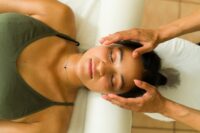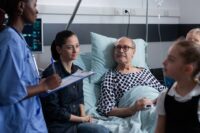Senior Adults for Greater Education (S.A.G.E.) is a non-profit organization that promotes involvement of people 55 and over in public schools. S.A.G.E. celebrated its 20th school year in 2019 and provides positive role models and mutually rewarding intergenerational experiences for students and senior adults. The organization was founded in 1999 by Beryl Katz, who recognized that the wisdom and talent of the older members of the community were being underutilized. S.A.G.E. unites youth and seniors in their quest to enrich education and leave a legacy for future generations.
Senior citizens bring a diverse breadth and scope of knowledge that can offer students experiences that can’t be learned from textbooks alone. Volunteers help to develop communities and build friendships and connections between the generations and within the community (www.beasage.org).
I’m an RN who retired “from a paycheck,” not from nursing, in 1999 after a 39-year career in home health and hospice care as a staff nurse, supervisor, and 22 years as an administrator. Several years ago, my church bulletin noted that volunteers were needed at an elementary school in my neighborhood. I knew two friends who were S.A.G.E. volunteers and had shared their positive experiences. I contacted S.A.G.E., completed the application, was credentialed by the school district, and began my volunteer opportunity with Miss C. and her kindergarten class in 2016. The past 7 years have been an interesting and rewarding volunteer opportunity.
As a home care nurse, I was always confident meeting new patients and families. In addition to performing my professional responsibilities, I enjoyed the personal interactions with patients and families. I learned from these individuals to “be present and listen” rather than just “do” what needed to be done during my visit. My role as a volunteer allows me to be present, listen to the kindergarteners, provide support, and do what I can to assist the teacher.
I’m in the classroom from 8:30 to 11:00 one morning a week. I listen to morning announcements, recite the Pledge of Allegiance, and participate with the children during Morning Circle when they share special experiences, what they did the previous evening, and what they look forward to doing. During playtime, I’m available to observe, offer help, tie shoe laces, be in the audience for a puppet show, or place an order for food from the play kitchen. I sometimes help with math and Kid Writing. I’m constantly amazed at the knowledge the 5-year-old’s have and their ability to count, spell, and print.
For months in 2020 and 2021, I participated each week in the virtual classroom. I returned to the classroom in 2022, although students and teachers returned earlier. There were many challenges teachers experienced during those months. The many creative efforts they implemented to continue to teach on-screen while contending with distractions, deserve praise and admiration.
In May, during National Nurses Week, the teacher invites me to participate during story time. I read a book that shares what nurses do in the various types of nursing and also lets them know that mommies and daddies can be nurses. I bring my stethoscope and sphygmomanometer and explain their use. I show them a picture of me when I wore a white uniform and cap at work. Children are eager to share their experiences of visiting a doctor or the school nurse, having a new brother or sister, or experiencing the death of a family member or pet.
A few years ago, one of the students made a drawing for me. She included many items that I mentioned during Nurses Week story time: fruit, milk, babies, a bottle, and a nurse holding hands with children, similar to the picture on the front of the book I shared. Her detailed drawing was amazing.
Students reinforce the importance of being present. The shy students need encouragement, some need a shoe lace tied, and others need a listening ear. I’m constantly amazed at the knowledge and abilities at their young age. Their imagination during playtime is fun to watch. Asking what a particular item they are building represents, rather that stating what I think it is, allows the children to share their imagination and enthusiasm. I again reflect on the importance of “being” rather than “doing.”
In October, I provide mini pumpkins for each student to decorate. The children’s imagination allows them to express themselves through the way they paint their masterpieces. In spring, I plant flower seeds and the growth is measured each week. The increased height becomes part of the math lesson. Students use a ruler to measure the flowers each week, they identify the number on the ruler, and then decide if the plant was higher or the same as the week before.
Benefits I Experience
I appreciate the many benefits associated with my non-paid opportunities. Sometimes it’s a hand-drawn picture that’s waiting for me or thank you notes at the end of the school year. In May 2022, the teacher asked me to join the class remotely on my birthday when I wasn’t scheduled to be in the classroom. I was greeted by the students singing Happy Birthday Mrs. Harris, followed by each child reading their personal card to me (which the teacher gave me the next week). These memories will last my lifetime.
My husband always told me that the only thing I retired from was a paycheck. He’s correct. I continue as a PA-licensed RN and my professional nursing responsibilities as an author, editor, and member of numerous healthcare and other professional organizations and committees. I’ve serve as a non-paid professional faith community nurse since 2000 at the church where I’m a member. Being a S.A.G.E. volunteer offers me the opportunity to continue to share my nursing knowledge through interactions with children.
My advice to nurses is to take advantage of every non-paid opportunity that’s available and fits your interests and schedule, including volunteering in a classroom. This includes being present to listen to each child as they share what’s important at that moment. It also includes being available to assist the teacher with specific tasks.
My non-nursing interests, such as volunteering, help to keep me balanced and physically and mentally healthy. At age 86, I look forward to volunteering as long as God continues to bless me with good health and the opportunity to interact with children on an intergenerational basis.



















1 Comment. Leave new
This post was absolutely touching. I had never heard of S.A.G.E before. While reading it my heart smiled. I have a first grader and I would love for her to have the opportunity to have something like this available to her. I am currently in my second year of nursing and cannot wait to practice. I volunteer in my daughters classroom at least x2/month and it is one of my favorite things to do. To see my daughter and all her classmates happy to have me there. Their stories, hugs, smiles, eagerness to learn and participation are incredible. Lastly I love how you mentioned being present and listening rather than just doing. I wish more would do the same. Thank you Marilyn.